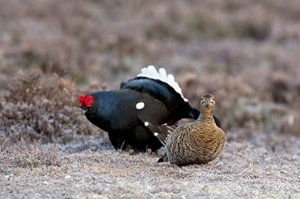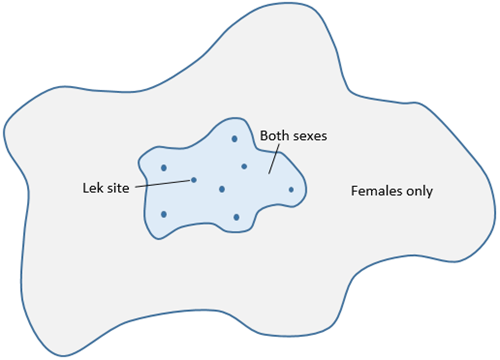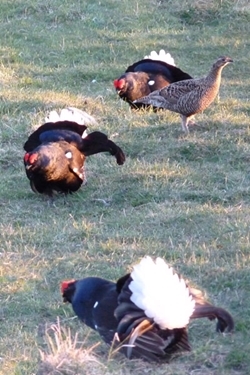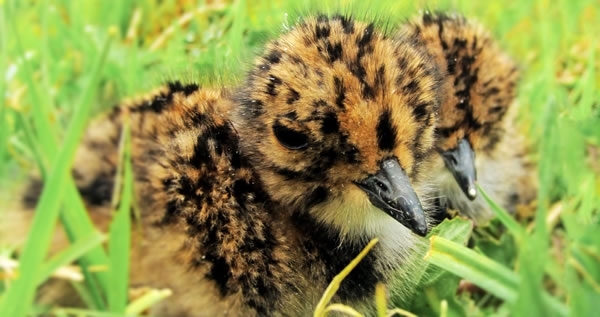Key points
- Black grouse have been declining in the UK for many years. In England, conservation schemes helped stem the decline and increase numbers between 1998-2006, but the area they live in (the range) did not increase.
- It was thought that range expansion was limited by young males not travelling far from the where they were born whereas young females travel much further – and on the edge of the range into areas where there are no males.
- To help the population expand, we caught and moved male black grouse into specially selected sites on the edge of the current range.
- Released males survived, settled and displayed, and attracted females, which bred successfully.
- This translocation helped to increase black grouse population range.
Background
 Black grouse were widespread throughout England 150 years ago, but numbers and range have since been falling. Populations are measured using the number of males, which are surveyed by counting those attending mating display sites known as ‘leks’. This ritual consists of multiple males gathering before dawn to display and attract females. In 1998, we surveyed the entire English population, and only 773 males remained, largely confined to the North Pennines Area of Outstanding Natural Beauty (AONB). A suite of conservation measures were implemented, and numbers increased to 1,029 in 2006, but the occupied range remained similar.
Black grouse were widespread throughout England 150 years ago, but numbers and range have since been falling. Populations are measured using the number of males, which are surveyed by counting those attending mating display sites known as ‘leks’. This ritual consists of multiple males gathering before dawn to display and attract females. In 1998, we surveyed the entire English population, and only 773 males remained, largely confined to the North Pennines Area of Outstanding Natural Beauty (AONB). A suite of conservation measures were implemented, and numbers increased to 1,029 in 2006, but the occupied range remained similar.
Our research has shown that adult black grouse are ‘site faithful’ – they stay at the same site year on year to breed. However, in their first year, young males and females disperse. Young males only disperse a short distance (up to 1km) and tend to join the local lek, whereas females travel an average of 10km, and sometimes up to 19km.
This difference in dispersal distance means that, at the edge of the range, females are moving into an area where there are no males, and range expansion is limited. This is shown in figure 1, below.

Figure 1: Dispersal of males (blue) and females (grey) from leks. Males travel on average 1km to
establish a territory and mate, whereas females travel on average 10km. This means on the edge of the established
range, females are moving into areas where no males are present, which may be limiting range expansion.
What they did
In this study, the scientists aimed to help black grouse stimulate range expansion on the southern edge of the established population in the North Pennines, by capturing male black grouse and moving them to suitable habitat just outside their current range. Males were caught from donor leks within the core of the population range. The number of birds attending these leks had to be stable or increasing, and consist of ten or more males, with no more than two males taken, and only in years when breeding success was at or above average. Over nine years, 62 birds were moved.
These birds were then moved to three carefully chosen release sites in the Yorkshire Dales National Park and the nearby Nidderdale AONB, within the natural female dispersal area. They were fitted with radio transmitters to allow monitoring, and released within three hours of capture.
What they found
 In the first spring following release, 48 of the released birds were still alive, of which 47 were observed displaying. Some of these displayed at new lek sites, and some males moved to display at established leks. Males displayed at leks on average 3.6km from their release site (ranging from 0.6 to 27.1 km), females were observed with displaying males, and females were seen later in the year with chicks. The leks that have been established have persisted, with total numbers of displaying males at release areas increasing from one male in 2006 to 44 males at 14 leks in 2015. Overall survival of released birds has been good, and similar to unmoved birds.
In the first spring following release, 48 of the released birds were still alive, of which 47 were observed displaying. Some of these displayed at new lek sites, and some males moved to display at established leks. Males displayed at leks on average 3.6km from their release site (ranging from 0.6 to 27.1 km), females were observed with displaying males, and females were seen later in the year with chicks. The leks that have been established have persisted, with total numbers of displaying males at release areas increasing from one male in 2006 to 44 males at 14 leks in 2015. Overall survival of released birds has been good, and similar to unmoved birds.
Black grouse range is measured by looking at how many squares of a 10x10km grid are occupied by the species. This translocation project has contributed to range expansion on the southern fringe of the range, leading to the recolonisation of seven new squares.
What does this mean?
Conservation efforts to support the black grouse can help increase their numbers. During the period of this project, black grouse numbers in the UK rose further – to 1,437 males in 2014, but range expansion has been slow.
Translocating male black grouse has helped to recolonise previously occupied areas on the southern edge of the established population range. In appropriate circumstances, where habitats are suitable and predator control is performed, translocation can be a useful tool to help stimulate range expansion.
Read the original abstract
Warren, P., Atterton, F., Anderle, M., & Baines, D. (2017). Expanding the range of black grouse Tetrao tetrix in northern England through translocating wild males. Wildlife Biology, 2017: wlb.00242: 1-7. DOI: 10.2981/wlb.00242.

Will you join our revolution?
This is a once in a generation opportunity - the future is now in your hands
With your support, we can make a real difference to conservation policy. Any amount you can give will get our research into the hands of politicians and the public to keep conservation policy on track.
£25 could help us to turn our research papers into easy, digestible summaries to show ministers and civil servants what can be achieved by those with a passion for the British countryside
£100 will help us to give the wider public a true picture of what is being done for wildlife on farms and estates
£250 allows us to monitor how the media report on the role of farming and fieldsports in conservation and correct misinformation